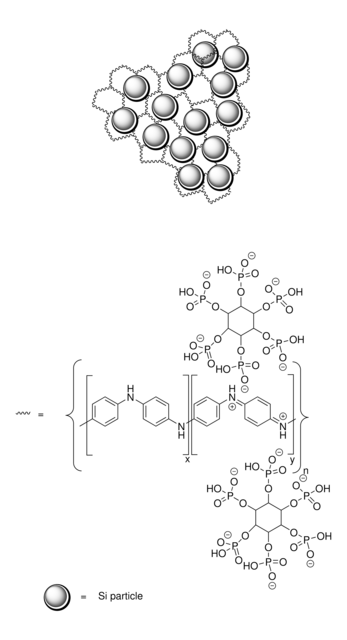912409
High-performance silicon anode
1 micron silicon particles in crosslinked conducting polyanaline matrix
Sinónimos:
Doped polyaniline, Si encapsulated in 3D crosslinked polyaniline, Si/PANi composite, Silicon micron particle
About This Item
Productos recomendados
Nivel de calidad
formulario
solid
¿Está buscando productos similares? Visita Guía de comparación de productos
Aplicación
This silicon/PANi composite utilizes a doped, intrinsically conductive, 3D cross-linked polyaniline as matrix, which could function as both the conductive binder and the polymer electrolyte for silicon-based electrodes. Previous study for a similar silicon-based three-dimensional conducting polymer composite demonstrated increased electrochemically performance due to short diffusion paths and good 3D connectivity, and resulted in a marked improvement in cyclability, with over 90% capacity retention after 5,000 cycles.
This composite is made by encapsulating silicon particles in an in-situ polymerized 3D-crosslinked conductive polyaniline framework. This Si/PANi composite not only allows fast electrical and ionic transport, but also provides free space to allow giant volume expansion. This Si/PANi composite provides a ready-to-use electrochemically active silicon composite that would increase the capacity of conventional lithium ion battery, and improve the cycle-life of Si-based anodes.
Código de clase de almacenamiento
11 - Combustible Solids
Clase de riesgo para el agua (WGK)
WGK 3
Punto de inflamabilidad (°F)
Not applicable
Punto de inflamabilidad (°C)
Not applicable
Elija entre una de las versiones más recientes:
Certificados de análisis (COA)
Lo sentimos, en este momento no disponemos de COAs para este producto en línea.
Si necesita más asistencia, póngase en contacto con Atención al cliente
¿Ya tiene este producto?
Encuentre la documentación para los productos que ha comprado recientemente en la Biblioteca de documentos.
Nuestro equipo de científicos tiene experiencia en todas las áreas de investigación: Ciencias de la vida, Ciencia de los materiales, Síntesis química, Cromatografía, Analítica y muchas otras.
Póngase en contacto con el Servicio técnico






